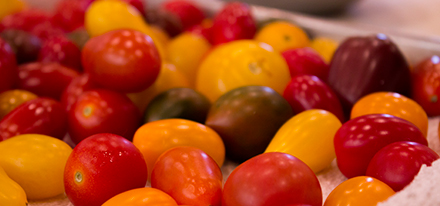As the year continues, it is important to keep those New Year’s resolutions and goals going. Whether it’s working out, reading more, or meditating, finding the best system for you is important. Another New Year’s goal CBCI chefs often hear about is committing to a diet or “eating healthier.” This can be difficult to commit to for an entire year, however, keeping a balanced diet may be easier for people to follow.
What is a balanced diet?
A balanced diet gives your body a variety of nutrients it needs to function correctly. In order to get the nutrients your body needs, most of your daily calories should come from:
- Fresh fruits
- Fresh vegetables
- Whole grains
- Lean proteins
- Legumes
- Nuts
Calories explained:
To keep it simple, calories in food refers to the amount of energy stored in that food. Your body needs those calories for walking, thinking, breathing, and many other important functions.
The average person needs 2,000 calories everyday to maintain their weight, however, that number also depends on age, sex, and physical activity level.
The source of daily calories are also important. Some foods provide calories, but very little nutrition– these are known as empty calories.
Examples:
- Cakes, cookies, & donuts
- Energy drinks & sodas
- Chips & fries
- Pizza
Why is a balanced diet important?
A balanced diet gives nutrients to your body, so that it works effectively, without this, your body is more prone to disease, infection, fatigue, and low performance.
An unbalanced diet combined with an absence of exercise can lead to obesity and eventually lead to type 2 diabetes and high blood pressure.
What to eat for a balanced diet?
A healthy diet should include the following:
- Vitamins, minerals, & antioxidants
- Carbohydrates (starches & fiber)
- Protein
- Healthy fats
Focus on the following food groups:
- Fruits
- Vegetables
- Grains
- Dairy
- Protein
Foods to avoid/limit:
- Highly processed foods
- Refined grains
- Added sugar & salt
- Alcohol
- Trans fats
Food groups explained:
Fruits: great as a snack or dessert, and they can satisfy a sweet tooth. Although they are higher in sugar it is a natural sugar. If you are looking for low sugar fruits try incorporating raspberries, strawberries, blackberries, and kiwis in your diet.
Vegetables: key source of essential vitamins, minerals, and antioxidants. Make sure to eat a variety of veggies; the greater the range of colors the more nutrients you are getting. Dark, leafy greens are great such as spinach, kale, broccoli, and collard greens.
Grains: whole products provide vitamins, minerals, and fiber. This is also a great way to add texture to a dish. Bread, pasta, and rice all come in whole grain options.
Proteins: meats and beans are primary sources of protein. This is essential for wound healing and muscle maintenance and development. Healthy animal protein include red meats, poultry, and fish. Plant-based protein is also a great way to fill this category. Options include lentils, beans, peas, almonds, sunflower seeds, and walnuts.
Dairy: this can provide essential nutrients such as protein, calcium, and vitamin D. Dairy-free milks are great alternatives as well. They can be made from flax seed, almonds, cashews, soy, oats, and coconuts.
Fats & Oils: this is essential for energy and cell health, however, too much fat can increase caloric intake which may lead to weight gain. It is important to avoid saturated fats and trans fat because they may lead to high cholesterol levels. Fats to keep in your diet are vegetable oils and fish oils. Fats to limit are butter, cheese, and heavy cream. Fats to lose are trans fats which come highly processed. Olive oil is considered to be a healthy fat, especially extra virgin olive oil.
Summary:
A healthy balanced diet should combine all the nutrients and food groups mentioned above. A great way to remember how much of each group to eat is the plate method from the USDA’s “ChooseMyPlate” initiative, which recommends:
- Filling half the plate with fruits & vegetables
- Adding just over one quarter with grains
- Filling just under one quarter with protein foods
- Adding dairy on the side or non-dairy replacement
The bottom line:
A well-balanced diet usually contains plenty of fresh plant-based foods, and limits the intake of processed foods.



